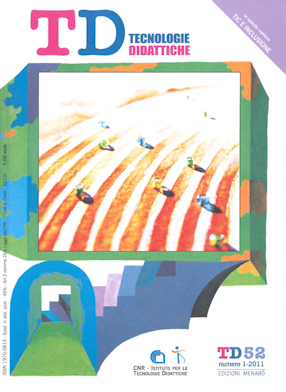Inclusive learning plans using ict: the Aessedi project
Main Article Content
Abstract
Article Details
Authors who publish with this journal agree to the following terms:
- Authors retain copyright and grant the journal right of first publication with the work simultaneously licensed under a Creative Commons CC BY 4.0 Attribution 4.0 International License.
- Authors are able to enter into separate, additional contractual arrangements for the non-exclusive distribution of the journal's published version of the work (e.g., post it to an institutional repository or publish it in a book), with an acknowledgement of its initial publication in this journal.
- Authors are permitted and encouraged to post their work online (e.g., in institutional repositories or on their website) prior to and during the submission process, as it can lead to productive exchanges, as well as earlier and greater citation of published work (See The Effect of Open Access)
References
Antonietti A., Castelli I., Fabio R.A., Marchetti A. (2003). La sindrome di Rett. Prospettive e strumenti per l’intervento. Roma: Carocci.
Bocconi S., Dini S., Ferlino L., Ott M. (2006). A proposito di accessibilità del software didattico. TD-Tecnologie Didattiche, 39, pp.43-49.
Boscolo P. (1986). Psicologia dell’apprendimento scolastico. Torino: UTET.
Castells M. (2009). Comunicazione e potere. Milano: Università Bocconi.
Collins A., Brown J. S., Newman S.E. (1989). Cognitive Apprenticeship: Teaching the Craft of reading, writing, and mathematics. In L. Resnick (ed.). Knowing, Learning, and Instruction: essays in honor of Robert Glaser. Hillsdale, NJ: Lawrence Erlbaum, pp. 453-494.
Cortigiani P. (2010). Wiki-schools: scuole che generano conoscenza connettiva. Rivista dell’Istruzione, 6, pp. 80-88.
Fogarolo F. (2007). Il computer di sostegno: ausili informatici a scuola. Trento: Erickson.
Ianes D. (2006). La speciale normalità. Strategie di integrazione e inclusione per le disabilità e i bisogni educativi speciali. Trento: Erickson.
Leonardi M. (2005). Salute, disabilità, ICF e politiche sociosanitarie. Sociologia e Politiche Sociali, 8, pp. 73-95.
Johnson D., Johnson R, Holubec E. (1996). Apprendimento cooperativo in classe. Trento: Erickson.
MIUR (2009). Linee guida sull’integrazione scolastica degli alunni con disabilità, URL: http://www.istruzione.it/web/istruzione/prot4274_09
(ultima consultazione febbraio 2011).
OMS (2001). Classificazione internazionale del funzionamento, della disabilità e della salute. ICF. Trento: Erickson.
ONU (2006). Convention on the rights of persons with disabilities, URL: http://www.un.org/disabilities/default.asp?navid=13&pid=150 (ultima consultazione febbraio 2011).
Palincsar A.S., Brown A.L. (1984). Reciprocal teaching of comprehension fostering and monitoring activities. Cognition and Instruction, 1(2), pp.117-175.
Rogoff B. (1990). Apprenticeship in thinking: cognitive development in social context. New York, NY: Oxford University Press.
Scataglini C., Cramerotti S., Ianes D. (2008). Fare sostegno nelle scuole superiori. Dagli aspetti teorico-metodologici alla dimensione operativa.
Trento: Erickson.
Vygotskij L.S.(1986). Pensiero e linguaggio. Firenze: Giunti-Barbera.
Wenger E. (2006). Comunità di pratica. Apprendimento, significato e identità. Milano: Raffaello Cortina.

